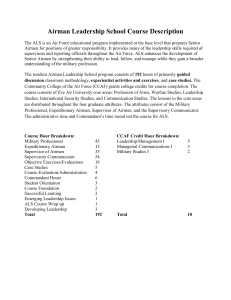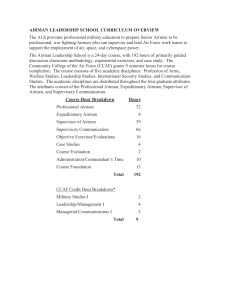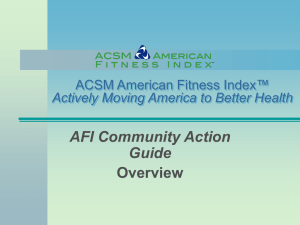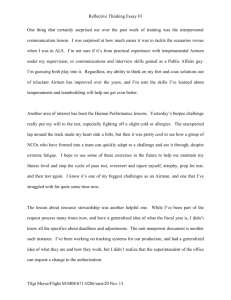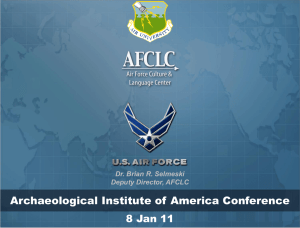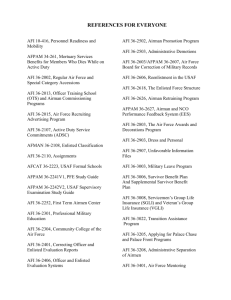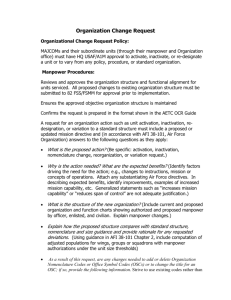Supervisor Career Counseling Guide
advertisement
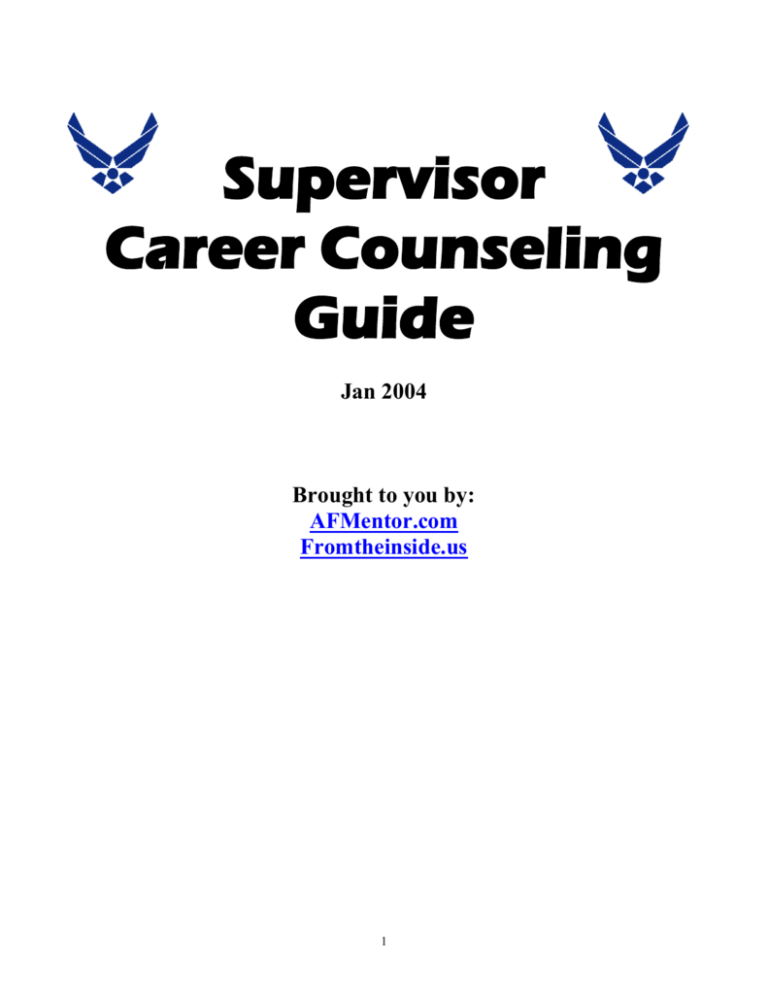
Supervisor Career Counseling Guide Jan 2004 Brought to you by: AFMentor.com Fromtheinside.us 1 TABLE OF CONTENTS Introduction Your Role Four Keys to Career Counseling Supervisor’s Enlisted Career Information Performance Feedback Enlisted Performance Reports Promotion Programs Special Trophies and Awards Program ` Decorations Training SRP/CJR/Full Enlistment Program/SRB Assignments Retraining PME Education (Deferment/AFELA/Commission) Retirements Summary Career Counseling Form Career Tracker 2 3 3 4 5 5 6 7 8 8 8 9 10 12 13 13 15 16 17 18 Air Force Career Counseling Tips to providing effective career counseling Introduction This guide is designed to help you provide a professional career counseling session with the people you supervise. It represents a collection of information from various Air Force Instructions, Air Force Pamphlets, handouts, and service agencies. It is not intended to provide complete information on the subjects discussed, but to highlight key areas during the counseling session. The mentoring of our airmen is one of the most important tasks you’ll do as a supervisor. As supervisors, we must ensure we give them the facts before they are faced with the decision to reenlist or separate. Most of us had someone throughout our careers who inspired and motivated us to be better than we would have been. The Air Force wants to make sure each individual contemplating a career decision has sufficient information about opportunities that are available, hence, the main idea behind career counseling and the Air Force benefits fact sheet. The Air Force needs our help in retaining the right number of first, second, and career airmen to sustain the right combination of manpower and skills. Supervisors and commanders play a critical role in an individual’s decision to stay with the Air Force. Your Role Defined by AFI 36-2618, The Enlisted Force Structure, para 4.1.1 (page 7) NCOs (Supervisors) must: 4.1.1 Consider the professional development of their subordinates as a primary responsibility. Provide career counseling to the subordinates on benefits, entitlements, and opportunities available in an AF career. Counseling occurs in conjunction with performance feedback counseling or when an individual comes up for quality review under the Selective Reenlistment Program. Review with each individual the AF Benefits Fact Sheet, and provide each individual a copy at the end of the counseling session. 1. First line supervisors are critical to successful career counseling because: You interface with your people on a daily basis You are the first point of assistance for airmen with career questions What you say can influence an entire work center 2. Remember to promote a “career mindset” If you can’t help - DON’T HURT! 3 Four Keys to Career Counseling 1. First: Know the facts! Pay and allowances Personnel programs (assignments, retraining, commissioning) Educational opportunities Services/Support Programs (BX, outdoor recreation, chapel) Career issues (promotions, professional military education) 2. Second: Give them the facts Must be timely to be beneficial Must be easy to understand 3. Third: Let them decide... What’s right for you may not be right for them... Be ready to provide additional guidance if needed 4. Fourth: Refer them to the experts when needed MPF, Education Center, Family Support Center, etc. Chief Master Sergeant, Superintendent, First Sergeant or other mentor Career Assistance Advisor Career Counseling Tools Attachments 1. Performance Feedback Worksheet Memory Joggers 2. Career Tracker 3. SRA Below-the-zone eligibility chart 4. References 5. Nomination for Award (AF Form 1206) 6. Web-site Listing Sheet Other Sources Your supervisor and/or mentor Chief Master Sergeant, Superintendent First Sergeant Experts at MPF Family Support Center – Transitional Assistance Program Career Assistance Advisor 4 SUPERVISOR’S ENLISTED CAREER INFORMATION Revised: 18 June 2003 The following information is to assist supervisors during their career counseling sessions. AFSC specific information should also be discussed and added to enhance the effectiveness of the guide. Supervisors don’t need to be an expert in any of these programs, but knowing who to call for concerns is important. 1. Performance Feedbacks OPR: Unit Command Support Staff (CSS) AFI 36-2627 a. AF Form 931 - AB thru TSgt AF Form 932 – MSgt thru CMSgt b. Purpose: 1. Explain duty performance requirements and responsibilities 2. Establish expectations and provide guidance 3. Tells ratee if they are performing as expected 4. Allows subordinates to discuss their expectations c. When: 1. Initial feedback sessions are held within 60 days of your assignment to a ratee. (CRO require initial feedback session) 2. A1C and below with less than 20 months of TAFMS: a follow-up session is due approximately 180 days after the initial feedback session. 3. Members who receive EPRs: A feedback session halfway between the date you were assigned to the ratee (or the closeout date of the ratee’s last EPR if you were the rater) and the projected closeout date of the ratee’s next EPR. 4. When the rater has not changed, a follow-up feedback is due 60 days after EPR closeout. 5. A feedback may be requested by the ratee if at least 60 days have passed since the last feedback. The rater has 30 days to complete the feedback. 6. For other occasions: see the information table on feedbacks in your PFE or AFI. d. Approaches: 1. The rater can choose numerous approaches to give feedback. Any of the following works well depending on the situation and the rater’s judgment. Remember – one of the fundamental rules of feedback calls for the rater to be him or herself. Three of the most common are listed below: a. Directive - Analyze the situation, develop a plan, tell the airman what to do. b. Nondirective – Encourage the airman to talk and get them to develop the solution. c. Combined – This approach draws on both directive and nondirective. It relies on the rater and ratee to develop solutions and offers the greatest flexibility. 5 2. Advantages and disadvantages of feedback approaches ADVANTAGES Directive - Quickest method - Good for immature or insecure ratee - Allows raters to actively use their Nondirective - Encourages Maturity - Encourages open communication - Develops personal responsibility Combined - Moderately quick - Encourages maturity - Encourages open communication experience DISADVANTAGES Directive - Doesn’t encourage maturity - Tends to discourage ratee Nondirective - Slowest method - Requires greatest supervisory skills Combined - May take too much time for some situations from talking freely - Tends to treat symptoms, not problems e. Explain the AF Fact Sheet on Air Force Benefits sheet and provide a hard copy (first and second term airman during feedback) 2. Enlisted Performance Reports (EPRs) OPR: Unit CSS AFI 36-2406 a. See sample of AF Form 910 - AB thru TSgt (AF Form 911 – MSgt thru CMSgt) b. Purpose: An official record of your performance (supervision must be at least 120 days under normal circumstances) c. When: 1. Initial EPR is submitted when an airman has 20 months of TAFMSD (LOE if <20 months and CRO occurs) 2. Submitted annually as long as there has been at least 120 days supervision after initial EPR has been closed out 3. Change of Rater (CRO) if 120 days have passed 4. For exceptions & special rules, see EPR submission table in your PFE or AFI. 3. Promotion Programs (SSgt - MSgt) OPR: Unit CSS AFI 36-2502 Note: Promotion quotas are tied to fiscal year end strength and are affected by funding limits, regulatory limits, and the number of projected vacancies in specific grades. The Air Force Personnel Center (AFPC) distributes the total promotion 6 quota among Air Force specialties. Members compete against individuals only in their AFSC. a. Weighted Airman Promotion system (WAPS): Total = 460 points Factors: PFE: 100 pts SKT: 100 pts TIS: 40 pts (2 pts for each year of TAFMS up to 20 yrs) TIG: 60 pts (1/2 pt for each month in grade up to 10 years) DEC: 25 pts (i.e. AFAM = 1 pt, AFCM = 3 pts, MSM = 5 pts) EPR: 135 pts (closed out within 5 years not to exceed 10 EPRs) EPR string (most recent to oldest for 5 years) Top EPR 5 x 50 = 250 x 27 = 6750 Next EPR 4 x 45 = 180 x 27 = 4860 Next EPR 5 x 40 = 200 x 27 = 5400 Next EPR 5 x 35 = 175 x 27 = 4725 Next EPR 5 x 30 = 150 x 27 = 4050 200 25785 25785 200 = 128.9 points b. Stripes for Exceptional Performers (STEP): Senior Raters can promote a limited number of airmen with exceptional potential to the grades of SSgt through MSgt. Call MPF for more information. c. WAPS calculator for estimates is available for use. http://www.afpc.randolph.af.mil/eprom/information/promocalc.xls 4. SrA Below-the-Zone OPR: Unit CSS (MPFM 01-07) a. Program designed to provide exceptionally well-qualified A1Cs a one-time BTZ promotion consideration opportunity to be effective 6 months prior to normal sew on. b. See the SrA BTZ chart and discuss when eligible to compete for BTZ. A1Cs are normally promoted to SrA with either 36 months of TIS and 20 months of TIG or 28 months of TIG, which ever comes first. They must possess a 3-skill level and be recommended by their unit commander. BTZ chart: http://www.afpc.randolph.af.mil/eprom/information/ c. Must have an EPR d. Compete for stripe at unit and/or base level 7 5. Special Trophies and Awards Program OPR: Unit CSS AFI 36-2805 a. Commander can set up awards to recognize AF members for their accomplishments b. Quarterly – front side of AF Form 1206 only. c. Annually – front and backside of AF Form 1206. d. Categories for Tinker see TI 36-2801 1. LEADERSHIP AND JOB ACCOMPLISHMENTS 2. SIGNIFICANT SELF IMPROVEMENT 3. BASE AND COMMUNITY INVOLVEMENT e. See current base guidelines for points allotted when scoring for each category. 6. Decorations OPR: Unit CSS AFI-36-2803 a. Above peers, sustained superior duty performance is a must b. Normal decorations 1. AFAM – Airman level responsibility 2. AFCM – NCO level responsibility 3. MSM – SNCO level responsibility 7. Training OPR: Unit Training Manager AFI 36-2201 a. Career Field Education and Training Plan (CFETP): The education and training document for an Air Force Specialty. It specifies what training is required for each skill level and duty position. 1. Specialty Training Standard (STS) - Lists skills and knowledge airmen need on the job. 2. Air Force Job Qualification Standard (AFJQS) - Comprehensive list of tasks that airmen assigned to the duty position must perform. b. AF Form 797, Job Qualification Standard Continuation - May be used to supplement the STS and AFJQS c. The work center or section level uses the CFETP and AF Form 797 to develop a task list of all wartime and peacetime tasks performed by the work center. d. Individual Responsibilities: 1. As a subordinate, it is critical to learn the tasks and initial only when fully confident at the level of training required. 2. As a supervisor, make sure your subordinates are properly trained and fully qualified for the level of competency required at their level. 8 8. Selective Reenlistment Program (SRP): MPF Bldg 323C, , 294-4448 AFI 36-2606 a. Reenlistment is a privilege, not a right. Commanders approve or deny reenlistment, but the supervisor will make recommendations to the commanders. b. First-term airmen receive SRP consideration at 33 months for 4-year enlistees or 57 months for 6-year enlistees. Career airmen are considered when they are within 13 months of ETS. c. First term airmen may extend for 12 months for personal convenience (See MPF for specific details). 9. Career Job Reservation (CJR) AFI 36-2606, MPF Bldg 323C, , 294-4448 a. System used by the Air Force to maintain a career job requirements file for each AFSC. b. All eligible first-term airmen must have an approved CJR in order to reenlist and it does not obligate you to reenlist. c. Individuals will receive a CJR rip and when it is near the time apply. The rip has dates of eligibility. They must go to the MPF to apply for their CJR. d. Window of opportunity: Four year enlistees request a CJR no earlier than the 35th month Six-year enlistees request a CJR no earlier than the 59th month e. Once your CJR has been approved, you must reenlist before the expiration date on the CJR. 10. Full Enlistment Program OPR: Career Enhancements AFI 36-2606 a. Reenlist 4 – 6 years in yearly increments, not to exceed 6 years (exceptions for HYT). b. Member can reenlist up to 3 months early. Number of months early will be added to the end of the enlistment, thus, member completes full-obligated service time. c. Program enables airmen to receive full SRB entitlement. (Note: Cannot go over 6 yrs in a reenlistment to include months added at the end.) Note: For full benefit of 6 yr SRB, reenlist on DOS 11. Selective Reenlistment Bonus (SRB) OPR:Career Enhancements AFI 36-2606 a. Three SRB eligibility zones (member can receive only one bonus per zone) 1. Zone A: TAFMSD between 3 to 6 years 2. Zone B: TAFMSD between 6 and 10 years 3. Zone C: TAFMSD between 10 and 14 years 9 b. Members who are in a tax-free zone anytime during the same month they reenlist, will receive their SRB tax-free. c. Consider investing in the Thrift Savings Plan (TSP) or individual investment program. See the financial counselor at Family Support for more information. 12. Assignments OPR, AFI 36-2611 a. Eligibility: Time on station (TOS) and Service Retainability 1. CONUS to CONUS: Career 36 months TOS First term 12 months TOS 24 months retainability - both 2. CONUS to Overseas: Career 24 months TOS First term 12 months TOS 3. Overseas to CONUS: 12 months retainability to return to CONUS after completion of Overseas tour. b. Base of Preference Program – Choice of up to 8 bases 1. First Term Airmen a. Choices of CONUS TO CONUS BOP, Overseas to CONUS BOP or In-place BOP (IPBOP) b. Must apply before reenlistment. c. Earliest to apply can be with CJR or retraining. d. Must have 8 months to apply and 12 months time on station to PCS (TOS) except with retraining. e. No TOS requirements for IPBOP-2 year assignment deferment. f. If denied, can resubmit same bases 6 months later or immediately submit new choices. 2. Career Airmen a. IPBOP (no time on station requirement to apply). b. CONUS TO CONUS BOP must have 41 months TOS at the time of application and at least 4 years TOS before PCS departure. c. Must not be an overseas volunteer or have other volunteer applications pending. d. If denied, can resubmit same bases 6 months later or immediately submit new choices. c. Permissive PCS 1. PCS initiated by a member and approved by AFPC authorizing the person to proceed on a PCS at their own expense—travel time is charged as leave. 2. CONUS base member can apply for reassignment to another CONUS base— manning at both the present and requested bases is the primary factor for approval. 3. FTA – apply 1 year 5 months and PCS at 24 months 4. Career Airman – apply at 2 years 5 months and PCS at 36 months 10 5. Member must have a valid reason to PCS other than desire. d. Voluntary Stabilized Base Assignment Program (VSBAP) 1. Provides a stabilized tour in exchange for volunteering for an assignment to a historically hard to fill location. 2. Must have 2 yrs 5 months TOS to apply and 3 yrs TOS to depart. 3. Locations: a. Minot AFB b. Cannon AFB c. Los Angeles AFS d. Grand Forks AFB e. Humanitarian Reassignment 1. Provides reassignment or deferment for AF members who have a severe shortterm crisis involving a family member that is resolvable within a reasonable time and their presence is considered essential to resolve the problem. 2. The initial period of deferment is usually 1 year. 3. AF may retrain member into another AFSC to enable member to PCS near family. f. Exceptional Family Member Program (EFMP) 1. Program designed to ensure members are assigned where the general medical services, medically related services, or special educational services for there eligible DoD dependents, to include dependent adults, can be met. 2. Member will be coded in the system and will only be assigned to a base where the necessary resources are available to take care of family. g. Overseas Enlisted Quarterly Assignments Listing (EQUAL): 1. Provides airmen a listing of the assignment requirements available for upcoming assignment cycles to overseas locations. 2. The list is located on the AFPC website, and requirements are identified by grade and location. h. EQUAL Plus – Special Duty Assignments 1. This system advertises unique assignments that cannot be advertised under EQUAL due to time constraints. 2. It shows assignments currently available and any special requirements or qualifications needed. 3. EQUAL Plus can be found on the AFPC website. i. CONUS Assignment Exchange, “The Swap” 1. Airmen find another willing airman at another CONUS location to swap. 2. Both must meet criteria: same grade/specialty/skill level/SEI (if required for assignment). j. Join Spouse Assignment 1. Policy: each member serves in own right, goal is to assign married military 11 couples to locations where they can establish joint household. 2. Actions consistent with AF requirements and assignment equality k. Extended Long OS Tour (ELT) Length 1. When you volunteer for PCS overseas to a long tour location (where the accompanied tour is 24 months or greater and the unaccompanied tour is 15 months or greater) you may agree to serve the standard tour plus an additional 12 months 2. ELT volunteers are considered ahead of standard overseas tour volunteers l. Homebasing Assignment 1. Advanced assignment back to same CONUS location. 2. In exchange, agree not to use entitlements to relocate dependents to a designated place, claim DLA, or ship/store HHG at government expense. m. Follow-On 1. Advanced assignment to preferred CONUS location/long OS location. 2. In exchange agree not to use entitlements to relocate dependents and HHG to place other than FO location, claim DLA or store HHG at government expense. 13. Retraining OPR: AFI 36-2626 a. Purpose: To balance the career force of each AFSC as needed and allow individual airmen a choice of career fields from which to pursue an Air Force career. b. Quality Retraining Program (CAREERS) - First Term Airmen: 1. ALL ELIGIBLE FIRST TERM AIRMEN CAN APPLY TO RETRAIN (AFSC and manning does not apply) 2. Window of opportunity: - Four-year enlistee - First day of 35th month of service until last day of 43rd month of service - Six-year enlistee - First day of 59th month of service until last day of 67th month of service - 15 to 9 month prior to DEROS (overseas) 3. Applicants must request consideration for retraining into a specialty that has retraining requirements according to the On-line Retraining Advisory located at the MPF. 4. Applicants are ranked for each retraining AFSC choice using the following factors: Most recent EPR, current grade, projected grade, next three EPRs, date of rank, TAFMSD, and AQE score in the applicable area. c. NCO Retraining Program: Second -Term and Career Airmen 1. Encourages airmen that are assigned in overage skills to retrain into shortage skills. Must posses at least a 5-skill level and meet eligibility factors. 2. Phase I – A voluntary phase announcing the start of the fiscal year program. Air Staff announces phase I listing those AFSCs with significant overages and 12 shortages. The objective is to get as many volunteers to apply in order to fill Air Force requirements. 3. Phase II – If retraining objectives for the fiscal year are not met through the voluntary phase, selective retraining becomes necessary. Airmen who possess a secondary or additional AFSC in a shortage skill are returned to those skills if in the best interest of the Air Force. If skill imbalances still occur, Air Staff will direct involuntary retraining into selected AFSC shortages. d. Ineligibility factors (for voluntary retraining - not inclusive) 1. Be ineligible for promotion or reenlistment. 2. Hold an “0” training status code (a non recommendation for upgrade training) 3. Be in Phase I of the Weight Management Program (code 1, 2, and 6 apply only to voluntary retraining). 4. Most recent EPR: a. Less than a 3 b. Referral c. Projected referral 5. Under investigation by OSI or law enforcement officials. 6. Note: Mandatory retraining have other procedures to follow 14. Professional Military Education Requirements OPR: Military Training AFI 36-2301 a. Airman Leadership School (ALS): 4.5 week course available to SrA after reaching 48 months of TAFMS or SSgt selectees – required to put on SSgt b. NCO Academy (NCOA): 5.5 week course available to TSgt and TSgt selectees – required to put on MSgt c. SNCO Academy (SNCOA): 6-week course available to MSgts, SMSgt selectees, SMSgts and CMSgt selectees – required to put on CMSgt 15. Education OPR: Education Center AFI 36-2306 a. Tuition Assistance: Air Force will pay 100 percent of tuition costs capped at $250.00 per semester hour ($4500 per year) TA does not include book costs. b. CLEP/DANTES testing: Current lists are available at the Education Center. Free tests to earn credit toward degree. c. Education Deferment 1. Within 12 months of completing degree program through off-duty study. 2. Apply, if approved, will provide one-year deferment from receiving orders so you can finish your degree at the college of your choice. 3. Ineligible if already selected for an assignment or the degree is equal/lower than one currently held. 4. Must have completed first term or obligated for 6 year first term. 13 5. Cannot be stationed overseas. d. Air Force Educational Leave of Absence: Education Center, 294-5716 AFI 36-2306 1. AFELA replaced the Bootstrap program. 2. Member must reenlist prior to applying for AFELA. 3. Up to one year for completing degree. 4. If application is approved, go to school full time, keep base pay only, and keep rank. 5. Participants have two months of additional obligated service for each month of the leave of absence in addition to any other period of obligated service. 6. No tuition assistance while in this program; you may use MGIB benefits. 7. This is not a commissioning program. 16. Commissioning Programs OPR: Education Center, AFI 36-2013 (See Ed Ctr for Commissioning Program briefings) a. United States Air Force Academy (USAFA) 1. If you are single with no dependents and meet the age requirements, you may apply to USAFA. 2. USAFA provides 4 years of academic education with military and physical training. b. Air Force Reserve Officer’s Training Corps (AFROTC) 1. This program allows airmen to receive an AFROTC scholarship to attend a college of choice if it offers a 4-year AFROTC program. 2. If accepted, discharged from active duty and enlisted in the AF Reserve. 3. Upon completion of your degree and AFROTC requirements, receive commission in the AF. c. Airman Education Commissioning Program (AECP) 1. If selected, AF will allow up to 36 months to complete work in a full-time course of study at a civilian educational institution. 2. Upon graduation, enroll in the Officer Training School (OTS). 3. Under age 30 (can be waived to 35) d. Officer’s Training School (OTS) 1. If you possess a baccalaureate or higher degree from an accredited college, you may be eligible for a commission through the OTS program. 2. See AFI 36-2012, Officer Training School and Airman Commissioning Programs, for specific guidance. 3. Under age 30 by commission date (can be waived to 35) e. Medical Service Direct commission Program: A program controlled by the Medical Service Corps (MSC), which allows for enlisted members with master degrees to get commissioned and be a member of the MSC. f. Scholarships for Outstanding Airmen (SOAR): Discharged from active duty to earn a degree with AFROTC scholarship. g. Leaders Encouraging Airman Development (LEAD) Program: Commanders seek outstanding airman with less than 6 years of service for appointment to the AF Academy and AFROTC scholarship programs. h. AFROTC Professional Officer Course Early Release Program (AFROTC –POC-ERP) 14 1. This program allows completion for a 2 year AFROTC non-scholarship allocation to attend a college of choice if it offers a 4-year AFROTC program. 2. If selected, discharged from active duty and enlisted into the AF Reserve. 3. Upon completion of degree and AFROTC requirements, receive a commission in the AF. 17. Retirements OPR: AFI 36-2306 a. Receive retirement check without contributing to retirement plan b. Current Pay Plans Plan Eligible Pay Formula Max is 75% of base pay Final Base Pay Entered service prior to 8 Sep 1980 2.5 % times the years of service times basic pay High – 3 Entered service between 8 Sep 1980 and 31 Jul 1986 2.5 % times the years of service times the basic pay of average of the highest 3 years Redux Entered service after 1 Aug 1986 40% of base pay at 20 years, 3.5% for every year over 20 – up to 75% at 30 years of service 1% less of Cost of Living Allowance with “onetime catch up” at age 62 * Note: At each members 15 year TIS, a decision must be made to take the High 3 or Redux plan. 15 Summary The United States Air Force is the most powerful Air Force in the world. But, what will tomorrow bring? When you effectively career counsel, you: Promote a common understanding of the rewards of serving in the USAF Instill a sense of pride among AF members in being part of an organization that does worthy work around the globe. Remember; get to know the Air Force—personnel programs, education programs, benefits, compensation, history, and heritage. Use AF Benefits Fact Sheet while doing performance feedbacks (mandatory). Promote TOTAL FORCE—active, guard, and reserve; both military and civilian. Support We Are All Recruiters (WEAR) and the Recruiter Assistance Program (RAP). YOU are the key to successful counseling and there are tools available to help you. 16 Career Counseling / Follow Up Form Use this form in conjunction w/Supervisor Career Counseling Guide 29 Oct 2002 Name _____________________________ Duty Title _________________________________ Feedback Date _____________ Career Goals ___________________________________________________________________ ______________________________________________________________________________ During counseling session, mark their interests and follow up (F/U) date SrA BTZ ______________________________________________________________________ F/U __________________________________________________________________________ Awards_______________________________________________________________________ F/U __________________________________________________________________________ Training Courses________________________________________________________________ F/U __________________________________________________________________________ Assignments___________________________________________________________________ F/U __________________________________________________________________________ Special Duty___________________________________________________________________ F/U __________________________________________________________________________ Retraining _____________________________________________________________________ F/U __________________________________________________________________________ Education _____________________________________________________________________ F/U __________________________________________________________________________ Ed Deferment __________________________________________________________________ F/U __________________________________________________________________________ AFELA_______________________________________________________________________ F/U __________________________________________________________________________ Commissioning_________________________________________________________________ F/U __________________________________________________________________________ Other_________________________________________________________________________ F/U __________________________________________________________________________ 17 Career Tracker MUST KNOW DATES FOR__________________________TAFMDS______________ Milestone Promotion to Amn (AFI 36-2502) Promotion to A1C (AFI 36-2502) Airman of the Quarter (Recognition Program – Quarterly and Annual) Initial Performance Feedback (AFI 36-2627) First Enlisted Performance Report (EPR) (AFI 36-2406) Periodic and Mid-course Feedbacks (AFI 36-2627) Montgomery GI Bill Good Conduct Medal (AFI 36-2803) SRA Below- the-Zone Promotion Eligibility (AFI 36-2502) Promotion to SRA (AFI 36-2502) Selective Reenlistment Program (SRP) (AFI 36-2606) Retraining Window (AFI 36-2626) Career Job Reservation (CJR) (AFI 36-2606) Assignment TOS Requirements (AFI 36-2110) Extensions of Enlistment Base of Preference (BOP) Assignments (AFI 36-2110) Requirements Recommended by your commander and have 6 months time in grade (TIG) Recommended by your commander and have 10 months TIG Assigned to the unit for 60 days of the quarter nominated. Factors: Leadership and job performance in primary duty; significant self-improvement; base/community involvement Initial feedback w/in 60 days from initial date of supervision. Supervisors discuss AF Benefit Fact Sheet, career counseling along with all other areas on the Feedback worksheet. A1Cs or below receive first EPR at 20 months time in service (TIS) Less than 20 months TAFMS: every 180 days until first EPR All others: Mid-course feedbacks: midway between the date supervision began and the projected EPR. Supervisors discuss AF Benefit Fact Sheet, career counseling along with all other areas on the Feedback worksheet. Begin in-service use after 24 months of continuous service 3 years in service for exemplary conduct. Must be recommended by Commander to receive. (awarded every 3 years) Considered 6 months prior to the fully qualified phase point (AFI 36-2502). This is a one-time consideration 36 months TIS and 20 months TIG or 28 months TIG, whichever occurs first 4-yr enlistees considered after completing 33 months TIS 6-yr enlistees considered after completing 57 months TIS 4-yr enlistees, 35th month through 43d month of service 6-yr enlistees, 59th month through 67th month of service 4-yr enlistees, 35th month through 43d month of service 6-yr enlistees, 59th month through 67th month of service Generally, CONUS to CONUS, 12 months TOS for first term airman CONUS to overseas, 12 months TOS for first term airmen First term Airmen may extend for 12 months for personal reasons (AFI 36-2606 rule 28) First Term Airmen must have an approved Career Job Reservation. Once CJR is approved, FTA are eligible to apply with 8 months time on station and at least 12 months 18 Date Selective Reenlistment Bonus Reenlistments (AFI 36-2606) Airman Leadership School (AFI 36-2301) Promotion to SSgt-MSgt Longevity Service Ribbon Non US Citizens NCO Academy NCO Retraining Program SNCO Academy Special Duty Opportunities HYT - SSgt HYT - TSgt HYT - MSgt HYT - SMSgt HYT - CMSgt Retirement Current pay plan High 3 TOS before PCS departure. Second term and Career Airmen must have 41 months TOS to apply and at least 4 years TOS before PCS departure. If denied, can resubmit same bases 6 months later Can apply in conjunction with retraining also Zone A= 17 months to 6 years TIS Zone B= 6 years to 10 years TIS Zone C= 10 years to 16 years TIS 4-yr enlistees, 45 months, at least AlC w/ 12 months TIG; 6-yr enlistees, 69 months, at least SrA or higher SrA with 48 months in service,(42 months in service if received remote assignment) plus 6 months retainability; must complete prior to pinning on SSgt Points for EPR maximum 135, TIS maximum 40, TIG maximum 60, Promotion Fitness Exam (PFE) Maximum 100 (points doubled if testing PFE only), Specialty Knowledge test (SKT) maximum 100, Decorations maximum 25 Awarded after initial 4 years in services and awarded every four years thereafter. Can apply immediately; US citizenship mandatory prior to reenlistment; can only extend 6 months for obtaining citizenship, if your application has been submitted. Mandatory for promotion to MSgt For TSgts and TSgt-selects NCO Retraining Program for upcoming FY is typically released in July – August of each year. Visit the AFPC Retraining website to check if your AFSC and grade are eligible to retrain Mandatory for promotion to CMSgt (E-9) For SMSgts and SMSgt-selects Some MSgts are competitively chosen to attend. Special Duty opportunities are available via the AFPC’s enlisted EQUAL PLUS assignment system SPECAT Assignment Guide identifies Special Duties and their requirements High year of tenure for SSgts is 20 years TAFMS High year of tenure for TSgts is 24 years TAFMS High year of tenure for MSgts is 26 years TAFMS High year of tenure for SMSgts is 28 years TAFMS High year of tenure for CMSgts is 30 years TAFMS You are eligible to retire if you have 20 years of Total Active Federal military Service. There are currently three different retirement options. First entered a uniformed service prior to 8 Sep 1980 Retired pay based on multiplier times basic pay received at time of retirement. First entered a uniformed service between 8 Sep 1980 and 31 Jul 1986 Retired pay based on multiplier times high 36 months average. After 20 years of service you get 50% of your highest 36 months paid averaged out to a monthly income. Cost of Living 19 REDUX Whole-person concept for BTZ, SMSgt and CMSgt selection Adjustments (COLAs) are given annually based on the increase in the Consumer Price Index (CPI), a measure of inflation. Under the High-3 System, the annual COLA is equal to CPI. First entered a uniformed service 1 Aug 1986 or later Retired pay based multiplier different than that of High 3 and the cost of living adjustment differs as well. After 20 years of service you 40% of your highest 36 months paid averaged out to a monthly income. Cost of Living Adjustments (COLAs) for retired pay are given annually based on the increase in the Consumer Price Index (CPI), a measure of inflation. Under REDUX, the COLA is equal to CPI minus 1%. Note you get $30,000 at your 15-year point under this program. Job performance, has individual demonstrated the highest qualities in all area related to their duties. Education, has the individual completed or working to complete CCAF degree, or is working on a degree program that complements their career field and enhances their ability to do their job. Breadth of Experience refers to the individual’s overall professional background, experience, and knowledge gained during their career. Job Responsibility, what was ask of the individual and how well was the job accomplished Professional Competence, how much does the individual know about the job, and how well do they accomplish it. Specific Achievements, has the individual been given any awards or decorations that sets them apart from others Leadership, what is the persons leadership potential Contact your supervisor, First Sergeant or the MPF functional experts with any concerns, questions. Check out AFPAM 36-2241, PME Study Guide for more details; (NOTE: exceptions may exist.) 20

